Last Sunday, like most Sundays, I went for a walk, though I really didn’t feel up to it. Tired, sniffly, and grumpy, I couldn’t face another damp, gray day. Nevertheless, I donned my gear and set out to find river otter scat. Yes, that’s how I spend my weekends!
Once outside of my home and my thoughts, my attention shifted to animal activity . . . and there was plenty to choose from. Lou and I were at a large wetland, or rather, an assemblage of wetlands utilized by many species. Mallards and Canada geese were ubiquitous and, on this day, wintering ducks joined them. Who would not be cheered by adorable buffleheads and their ring-necked companions?
We saw a northern harrier combing the marsh edges, a great blue heron heading towards the cedar swamp, and numerous red-winged blackbirds staking their claims. We also saw two muskrats swimming as the daylight waned.
But seeing was only part of the experience. Sound adds so much enjoyment to my walks. Most of the wetland birds delivered songs or calls, sometimes before they came into view. Sound also conveys information: direction of movement, type of activity, level of distress, and sometimes gender. It’s best to familiarize yourself with animal sounds before you hear them, but it doesn’t hurt to use a phone app or to make a field recording for subsequent identification. On any given day, sound might be your only contact with an animal. Sunday’s excursion provided several experiences of this kind. For example, the hooting of a great horned owl made me smile despite the impossibility of seeing the distant bird. Here’s a snippet of sound that reached the holly grove where I stood. You may need to turn up the volume.
Later, we heard some muffled wood frog calls, not quite “quacks” at this point. As evening temperatures rise into the mid-40s, they’ll be in full chorus. Then, just before we reached the car, a mourning dove delivered its owl-like song.
Indirect signs provide clues to past animal behavior. The best-known and most obvious of these are tracks, though identifying prints can be quite challenging. There are variations in gait, and the condition of snow or mud needs to be just right. What’s more, in a heavily visited location, human and dog prints dominate and sometimes obliterate those of other creatures. I've been postponing this topic in hopes of good snow cover, but it looks like we’ll be focusing on mud when the tracking post is finally published!
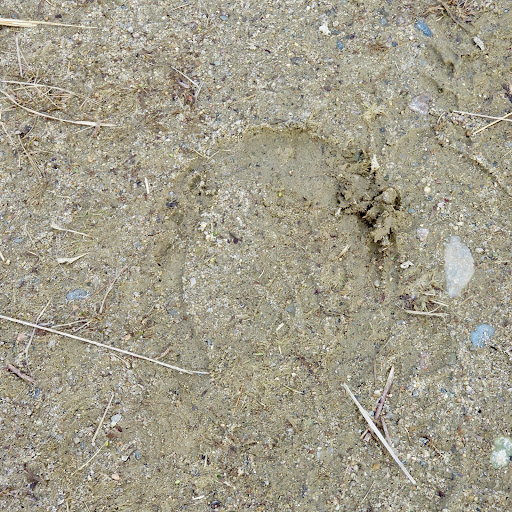
Prints of Another Mammalian Visitor
In the meantime, let’s consider some other evidence of animal activity.
Communication
White-tailed deer “rubs” were evident at several locations along the wooded trails, which is not surprising considering the high deer population in southeastern Massachusetts. Bucks make these abrasions with their foreheads and antlers to signal their presence and status to other deer in the area. Competitors and potential mates not only see the rub, they can smell the scents secreted from glands on the buck’s forehead. Rubbing against trees also helps the buck remove the “velvet” coating from his newly-grown antlers.
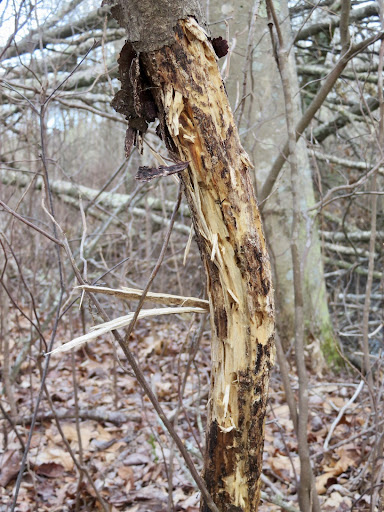
Shelter/Nests
During winter and early spring, last year’s bird nests are conspicuous. If you notice examples of nest placement now, you will be better prepared to observe new nests when they are concealed by vegetation. Birds nest in similar conditions each year. By attending to the finer details of nest size and materials, the amateur naturalist may be able to identify the exact species of its builder. In other words, having some knowledge of animal habits and habitats will improve the odds of seeing them in person.
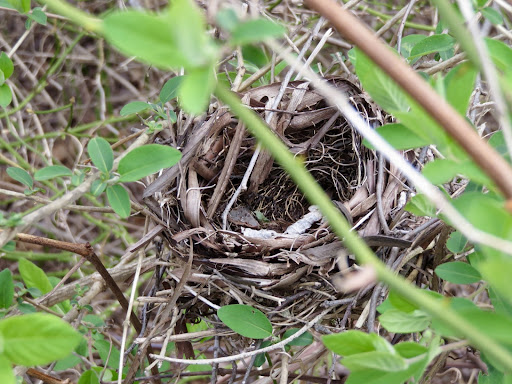
Twig & Grapevine Nest with Fine Lining in Dense Shrubbery: Catbird?
April 23, 2020
Mammals also construct shelter for themselves and their young. Here’s an example from my recent walk. The muskrat who built this den swam to it while I was fumbling with my camera’s video function. To give you a sense of the animal’s locomotion, I’ve included a clip from April, 2022 filmed at another location. This species is active year-round, so it is possible to see them whenever there is open water. Note: Dusk is a good time to look, for muskrats are primarily nocturnal.
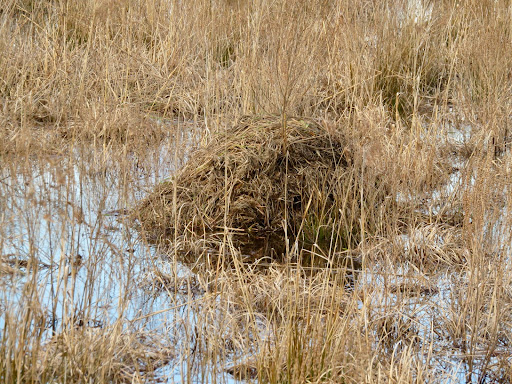
Closer to the brook, we discovered evidence of beaver activity. As you may know, beavers use their incisors to cut trees to build lodges and dams (and the food-producing pond habitat that results). The inner bark of trees, the cambium, is also a food source for these vegetarians. While this tree was felled some time ago, other naturalists have posted images of more recent “logging” at this property.
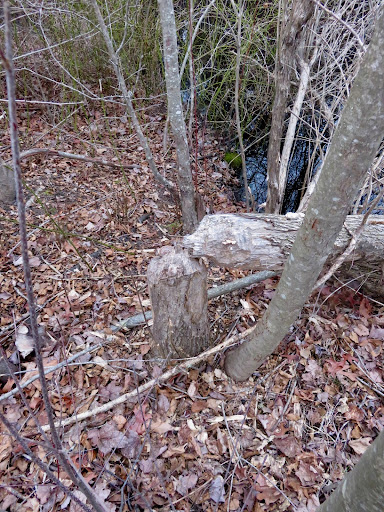
Diet/Feeding
Speaking of food . . . all animals eat and produce waste products. That waste, what trackers call “scat”, can help identify the animal who created it. The distinctions are partly based on the size of the animal. Scat from a black bear, for example, will be larger than that of a gray squirrel. The differences also reflect the animal’s anatomy and its diet. A coyote and a domesticated dog might be the same size and from the same animal family, but the coyote eats its prey with bones and fur, whereas the dog consumes trimmed, cooked meat from a can. Not surprisingly, their poop reflects this.
If you find scat in the field, take a moment to notice its size, shape, and contents. Does it contain grass, fur, bones, insects, seeds, cherry pits, or some other recognizable food? This might help you narrow the options to an herbivore, a carnivore, or an omnivore. Could the local surroundings provide that food?
In our area, some of the most commonly-seen scat are from cottontail rabbits, white-tailed deer, and eastern coyotes. Here’s what I found last Sunday:
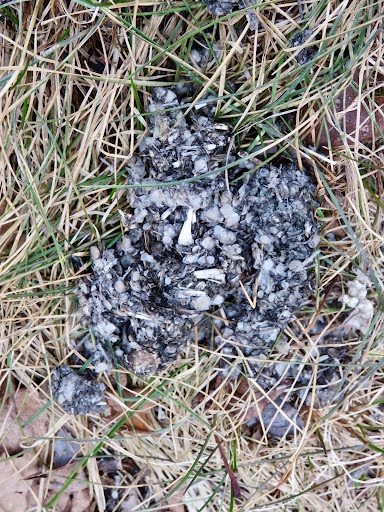
From a distance (such as a standing position), it looks like a jumble of gray-colored stuff. This particular specimen is not fresh but nor has it fully disintegrated. Looking closer, one sees two major ingredients: crustacean shells and fish scales. There are a few bones mixed in, as well.
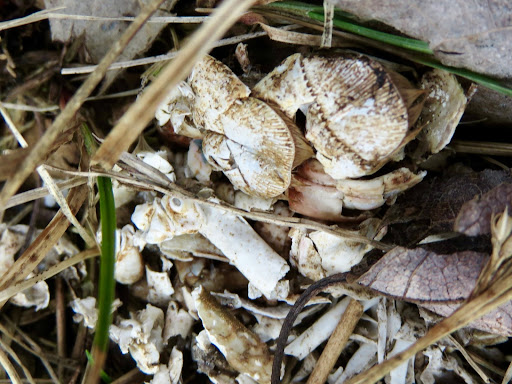
Crayfish Shells in Scat
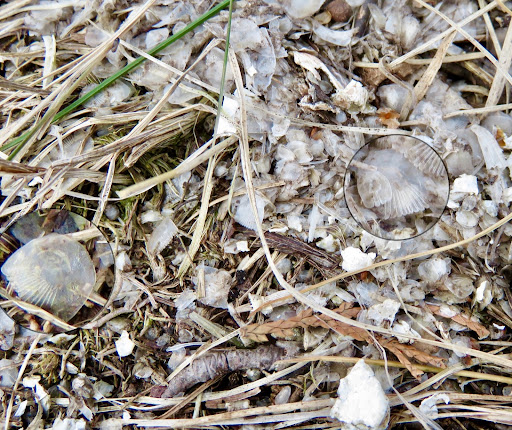
Fish Scales in Scat (with magnified highlights)
Moreover, the piles were found just a few feet from a sloping stream bank. Only two freshwater carnivores eat these foods – river otter and mink – and mink are less specialized, having a diet that includes small mammals. Otter! I didn’t see this animal; perhaps someday I will. Given the limited time I can spend outdoors, my observations are often hit or miss. But knowing that it lives near me, that we share the same space, enriches my experience of the world and reminds me of my responsibility to others.
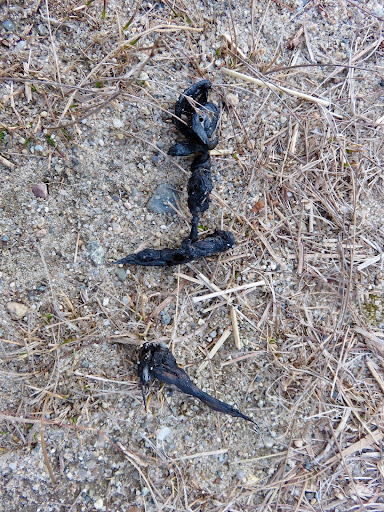
American Mink, I think.
These are just some of the highlights of an ordinary, local walk. There were animal holes and slides, a dead snake, and many more songs, nests, scats, and tracks. These clues complement our animal sightings and give a fuller picture of the dynamic world around us. Now’s a good time to get outside and look.
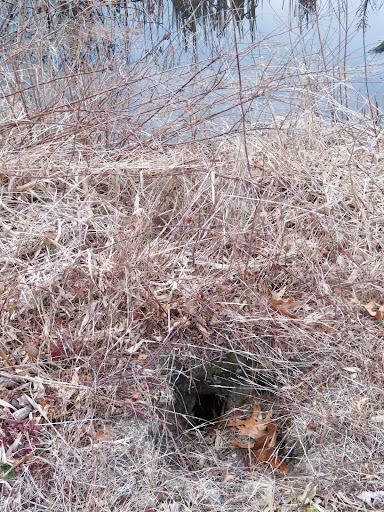
Who uses this burrow?